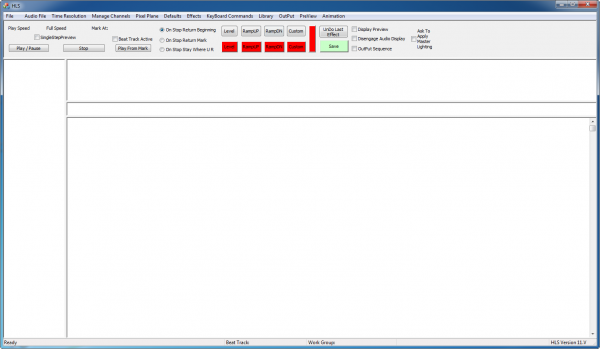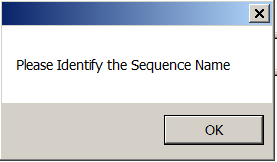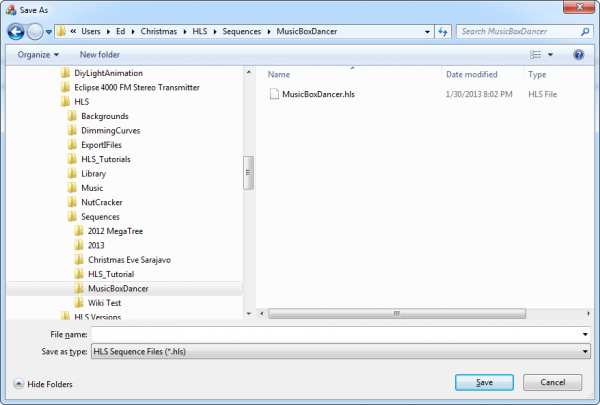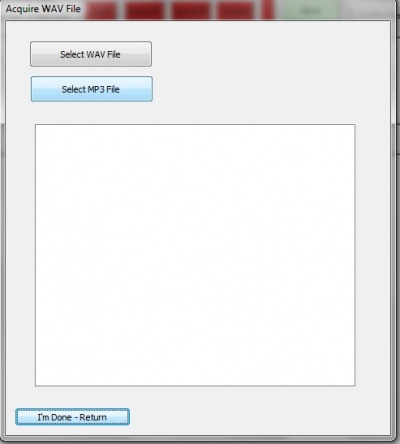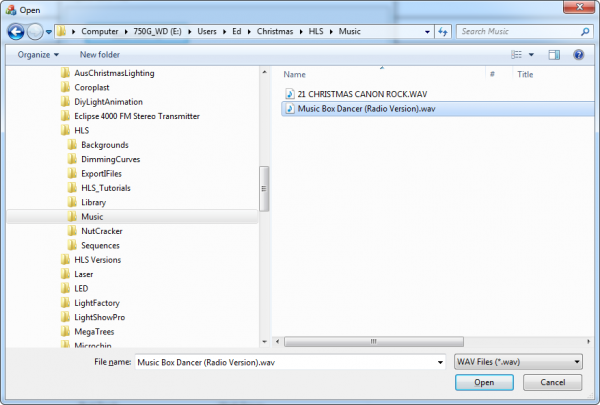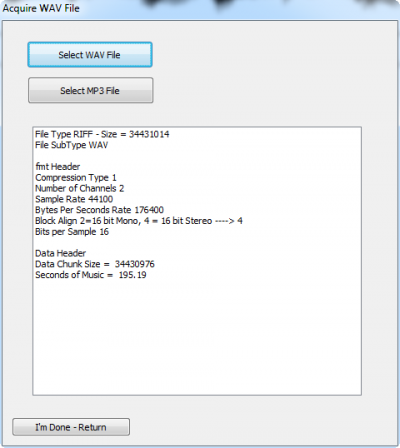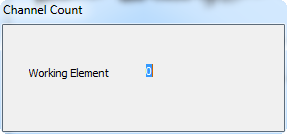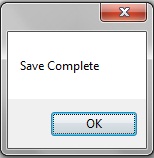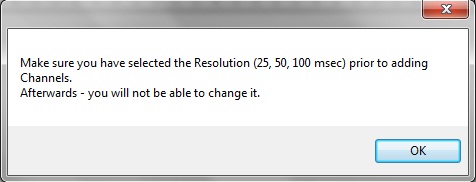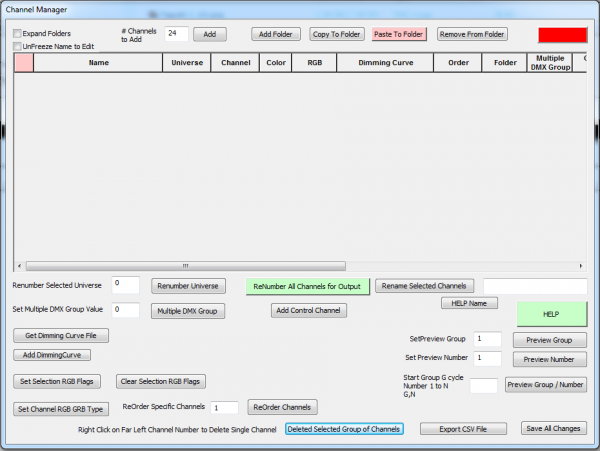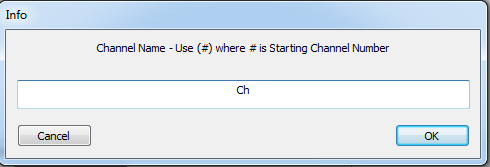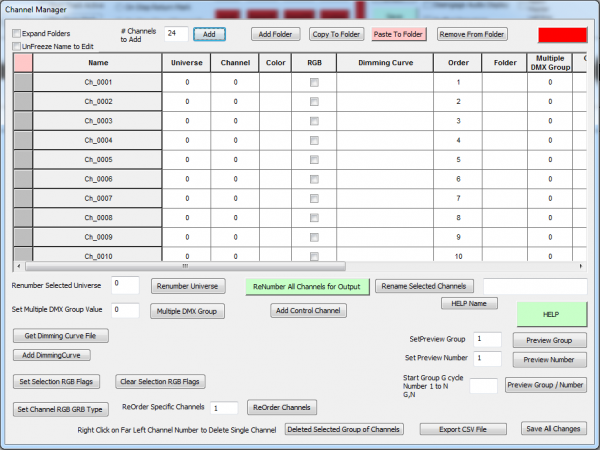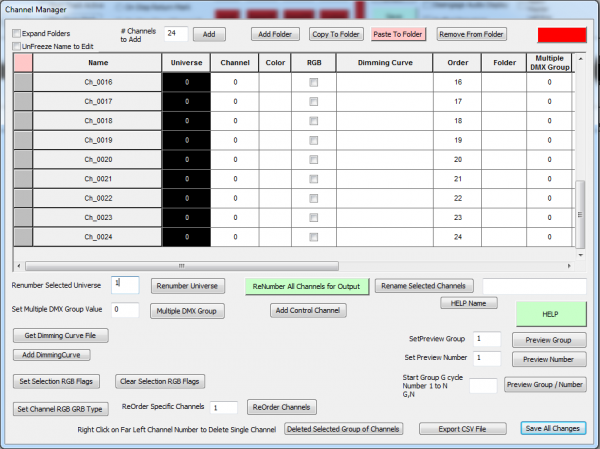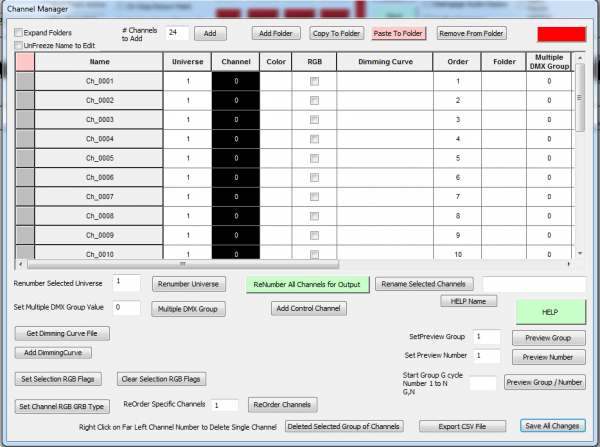Creating a Sequence-OLD: Difference between revisions
No edit summary |
m (OriginalHotrodder moved page Creating a Sequence to Creating a Sequence-OLD: This page name was needed for the UGaRM PDF version which is updated.) |
||
| (22 intermediate revisions by 2 users not shown) | |||
| Line 1: | Line 1: | ||
'''Back to:''' [[HLS Getting Started Manual]] | |||
''The following tutorial was based on Version 11V.''<br /> | |||
We will first create a simple sequence that has 24 outputs. For purposes of this example we will have one Renard 16 and one Renard 8 output module (24 outputs total). | We will first create a simple sequence that has 24 outputs. For purposes of this example we will have one Renard 16 and one Renard 8 output module (24 outputs total). | ||
The basic steps will be: | The basic steps will be: | ||
1.Add a | |||
2.Next we will configure the output channels. | 1. '''Add a mp3 or wav file'''.<br /> | ||
3.We will build a simple sequence. | (mp3 files were allowed starting with version 6V) <br /> | ||
4.We will create e preview screen so we can watch it run. | If you want to convert a mp3 to a wav file there are free converter programs on the web. Here is a link to one of them -[http://download.cnet.com/MP3-to-WAV-Decoder/3000-2140_4-10060498.html mp3 to wav converter] | ||
5.We will configure the Com port and Protocol and run the sequence with actual hardware. | |||
2. '''Next we will configure the output channels'''. | |||
3. '''We will build a simple sequence'''. | |||
4. '''We will create e preview screen so we can watch it run'''. | |||
5. '''We will configure the Com port and Protocol and run the sequence with actual hardware'''. | |||
Open HLS. You should see a screen like the one shown in Figure 1-1. Note that when you open HLS you are already creating a new sequence. You may only have one sequence open at a time. So if you are working on one and want to start another one, save your current sequence, shut HLS down and then restart HLS and work on the new sequence. | Open HLS. You should see a screen like the one shown in Figure 1-1. Note that when you open HLS you are already creating a new sequence. You may only have one sequence open at a time. So if you are working on one and want to start another one, save your current sequence, shut HLS down and then restart HLS and work on the new sequence. | ||
| Line 12: | Line 21: | ||
Figure 1-1 | Figure 1-1 | ||
[[File: | [[File:Figure1-1_v11.png|600px]] | ||
Next we will choose a WAV or mp3 file for the music to be used in this sequence. Click on the Audio File menu item at the top of the HLS screen and choose "Add Wave or mp3 File to this Sequence". Figure 1-2 will appear. | Next we will choose a WAV or mp3 file for the music to be used in this sequence. Click on the '''Audio File''' menu item at the top of the HLS screen and choose "Add Wave or mp3 File to this Sequence". Figure 1-2 will appear. | ||
Figure 1.2 | Figure 1.2<br /> | ||
[[File: | [[File:Figure1-2 ID sequnce name.png]] | ||
You will now name your sequence file and point HLS to where you want to save it ( | You will now name your sequence file and point HLS to where you want to save it <br /> | ||
(shown here in a folder with the sequence name in a "Sequences" folder, which itself is in the HLS folder). | |||
[[File:Figure1-2.1_v11.png|600px]] | |||
After you name your sequence figure 1.2a will appear: | After you name your sequence figure 1.2a will appear: | ||
Figure 1.2a | Figure 1.2a<br /> | ||
[[File: | [[File:Acquire-Wav-File-HLS.jpg|400px]] | ||
Next select either a WAV or mp3 file (see Figure 1-3). | |||
Figure 1-3.<br /> | |||
[[File:Figure1-3_v11.png|600px]] | |||
After you have chosen the mp3 or wav file, the screen shown in Figure 1-4 will appear. | |||
Figure 1 | Figure 1.4<br /> | ||
[[File: | [[File:Figure1-4_v11.png|400px]] | ||
After | After the text appears in the screen showing the mp3 or wav file was added, click on the "I’m Done – Return" button. <br /> | ||
You will get a "Channel Count" window like figure 1.4a. This window remains open for several (5-15 seconds), then you should | |||
see a save confirmation message like figure 1.4b | |||
Figure 1.4a<br /> | |||
[[File:Figure1-4.a_v11.png]] | |||
Figure 1. | |||
Figure 1.4b<br /> | |||
[[File:SaveComplete.jpg]] | [[File:SaveComplete.jpg]] | ||
| Line 49: | Line 71: | ||
Next, click on the Time Resolution tab at the top of the page and choose the time resolution you would like. 50 milliseconds is the default choice. | Next, click on the Time Resolution tab at the top of the page and choose the time resolution you would like. 50 milliseconds is the default choice. | ||
Next we will set up output channels. Click on the Manage Channels tab at the top of the page and then click on Manage Raw Channels. At this point you will see a message reminding you to choose your time period resolution before you continue (see Figure 1-5). Next, click on the OK button. | Next we will set up output channels. Click on the '''Manage Channels''' tab at the top of the page and then click on '''Manage Raw Channels'''. At this point you will see a message reminding you to choose your time period resolution before you continue (see Figure 1-5). Next, click on the OK button. | ||
Figure 1-5. | Figure 1-5.<br /> | ||
[[File:TimeReminder.jpg]] | [[File:TimeReminder.jpg]] | ||
Figure 1-6. | The Channel Manager screen will now as appear (see Figure 1-6). This is where we will add and configure channel outputs. For this example we will use a Renard 16 and a Renard 8 module. This would be 24 outputs total. We do not have to tell the software we have two controllers in this example as they are both Renards and they will both be attached to the same com port. <br /> | ||
[[File:Channel | Enter "24 for your 24 (16 +8) outputs in the window to the right of '''# channels to add''' then click the "Add" button. | ||
Figure 1-6.<br /> | |||
[[File:Figure1-6_v11.png|600px]] | |||
A "Channel Name" window will now open like Figure 1-7. The channel names will be created with whatever you enter here with <br /> | |||
"_0000", "_0001", etc appended to the end of it. In the example "Ch" was entered in this window and you can see the results in Figure 1.8<br /> | |||
Figure 1-7.<br /> | |||
[[File:Figure1-7.1_v11.png]] | |||
Figure 1-8.<br /> | |||
[[File:Figure1-8_v11.png|600px]] | |||
Next, we will change the '''Universe #''' entry. It cannot be zero for real outputs. In this example we will only have one type of controller and one port so we will only use one universe. To change the Universe number in the universe cells you need to first select the cells you want to change. You do this by left clicking in the first universe cell and while holding the left mouse button down, drag your mouse down to select the total number of cells you want to change. In this case we want all 24 changed to universe #1. Figure 1.8.1 shows the cells selected. Then enter "1" in the "Renumber Selected Universe" window, then click the "Renumber Universe" button. | |||
Figure 1- | Figure 1-8.1.<br /> | ||
[[File: | [[File:Figure1-8.1_v11.png|600px]] | ||
Figure 1-8 shows the screen after the | Finally you need to number the channels. Select all 24 channels by selecting the cells in the channel column just like you did with the universe cells. Then you will click the "ReNumber All Channels for Output" button. Figure 1-8.2 shows the screen after the channels have been numbered. | ||
Figure 1-8. | Figure 1-8.2.<br /> | ||
[[File: | [[File:Figure1-8.2_v11.png|600px]] | ||
'''Next: [[Setting | '''Next:[[Setting up Channels]]''' | ||
Latest revision as of 03:23, 25 March 2013
Back to: HLS Getting Started Manual
The following tutorial was based on Version 11V.
We will first create a simple sequence that has 24 outputs. For purposes of this example we will have one Renard 16 and one Renard 8 output module (24 outputs total).
The basic steps will be:
1. Add a mp3 or wav file.
(mp3 files were allowed starting with version 6V)
If you want to convert a mp3 to a wav file there are free converter programs on the web. Here is a link to one of them -mp3 to wav converter
2. Next we will configure the output channels.
3. We will build a simple sequence.
4. We will create e preview screen so we can watch it run.
5. We will configure the Com port and Protocol and run the sequence with actual hardware.
Open HLS. You should see a screen like the one shown in Figure 1-1. Note that when you open HLS you are already creating a new sequence. You may only have one sequence open at a time. So if you are working on one and want to start another one, save your current sequence, shut HLS down and then restart HLS and work on the new sequence.
Figure 1-1
Next we will choose a WAV or mp3 file for the music to be used in this sequence. Click on the Audio File menu item at the top of the HLS screen and choose "Add Wave or mp3 File to this Sequence". Figure 1-2 will appear.
You will now name your sequence file and point HLS to where you want to save it
(shown here in a folder with the sequence name in a "Sequences" folder, which itself is in the HLS folder).
After you name your sequence figure 1.2a will appear:
Next select either a WAV or mp3 file (see Figure 1-3).
After you have chosen the mp3 or wav file, the screen shown in Figure 1-4 will appear.
After the text appears in the screen showing the mp3 or wav file was added, click on the "I’m Done – Return" button.
You will get a "Channel Count" window like figure 1.4a. This window remains open for several (5-15 seconds), then you should
see a save confirmation message like figure 1.4b
Next, click on the Time Resolution tab at the top of the page and choose the time resolution you would like. 50 milliseconds is the default choice.
Next we will set up output channels. Click on the Manage Channels tab at the top of the page and then click on Manage Raw Channels. At this point you will see a message reminding you to choose your time period resolution before you continue (see Figure 1-5). Next, click on the OK button.
The Channel Manager screen will now as appear (see Figure 1-6). This is where we will add and configure channel outputs. For this example we will use a Renard 16 and a Renard 8 module. This would be 24 outputs total. We do not have to tell the software we have two controllers in this example as they are both Renards and they will both be attached to the same com port.
Enter "24 for your 24 (16 +8) outputs in the window to the right of # channels to add then click the "Add" button.
A "Channel Name" window will now open like Figure 1-7. The channel names will be created with whatever you enter here with
"_0000", "_0001", etc appended to the end of it. In the example "Ch" was entered in this window and you can see the results in Figure 1.8
Next, we will change the Universe # entry. It cannot be zero for real outputs. In this example we will only have one type of controller and one port so we will only use one universe. To change the Universe number in the universe cells you need to first select the cells you want to change. You do this by left clicking in the first universe cell and while holding the left mouse button down, drag your mouse down to select the total number of cells you want to change. In this case we want all 24 changed to universe #1. Figure 1.8.1 shows the cells selected. Then enter "1" in the "Renumber Selected Universe" window, then click the "Renumber Universe" button.
Finally you need to number the channels. Select all 24 channels by selecting the cells in the channel column just like you did with the universe cells. Then you will click the "ReNumber All Channels for Output" button. Figure 1-8.2 shows the screen after the channels have been numbered.
Next:Setting up Channels
